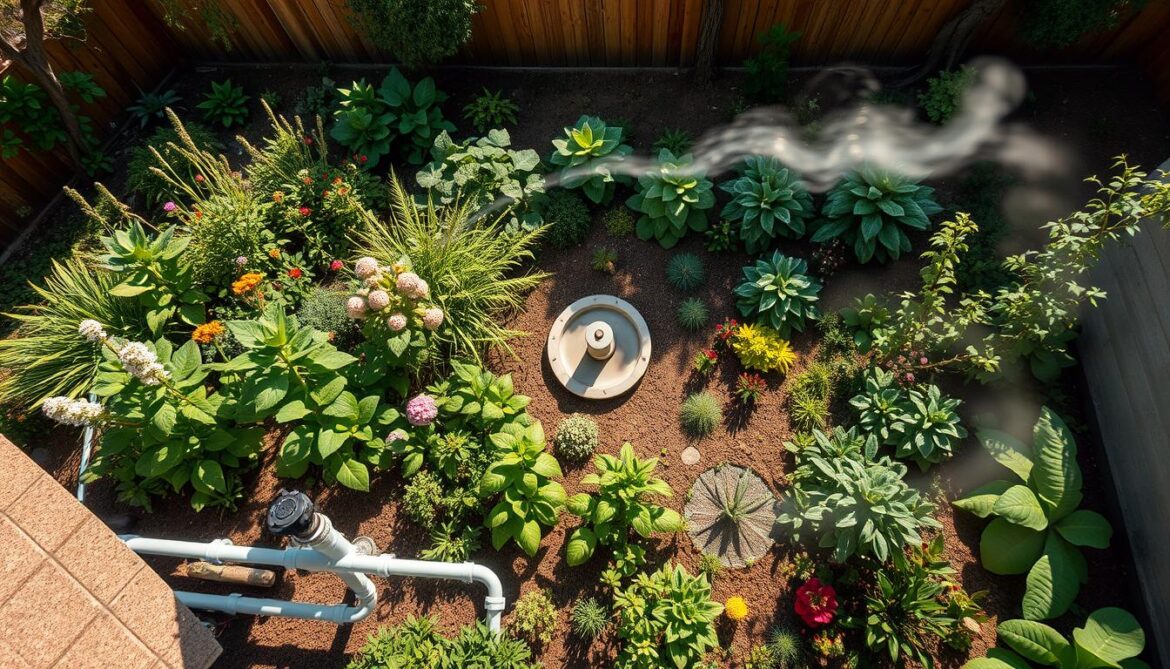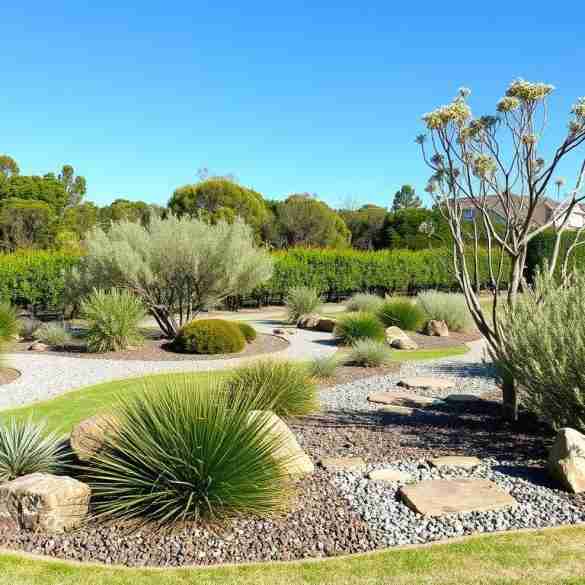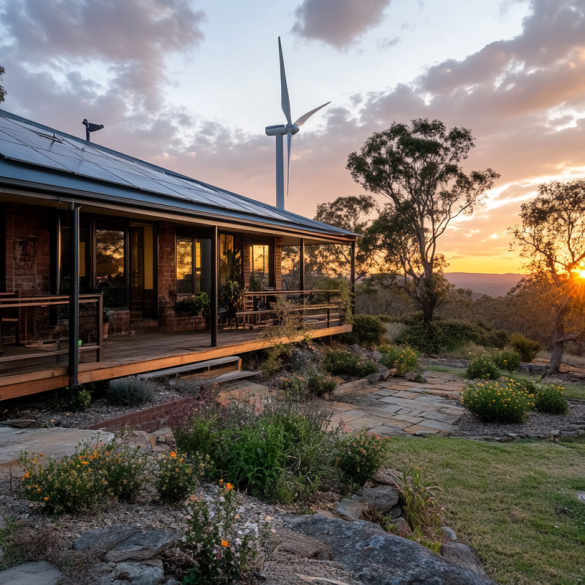Did you know the average U.S. household sends 40 gallons of gently used water down drains daily from showers, sinks, and laundry? That’s enough to nourish a small orchard every week. By Greywater-Safe Garden Planning, you can transform your yard into a drought-resistant oasis while slashing water bills.
Greywater systems work like nature’s own irrigation method, delivering moisture and nutrients directly to plants. As Sustainable Home Magazine notes, smart placement of mulch basins—shallow trenches filled with woodchips—under tree driplines mimics natural springs. This approach feeds roots without overwhelming them, even during seasonal dry spells.
Your soil type and sun exposure determine where to channel water. Fruit trees thrive with these nutrient-rich flows, while ornamental plants benefit from filtered greywater. Whether you choose DIY setups or professional installations, proper planning ensures your landscape gets exactly what it needs.
Table of Contents
Key Takeaways
- Reusing household water reduces waste by up to 40 gallons daily
- Mulch basins prevent runoff and boost soil health
- Position plants based on water needs and sun patterns
- Greywater carries natural fertilizers for stronger growth
- Simple systems can expand as your garden evolves
- Experts at Sustainable Home Magazine offer proven strategies
Foundations of Greywater-Safe Garden Planning
Every time you wash dishes or take a shower, you’re creating a hidden resource that could feed your plants. Greywater—gently used water from sinks, laundry, and showers—contains natural nutrients from soaps and food particles. Unlike blackwater from toilets, it’s safe for irrigation when managed properly.
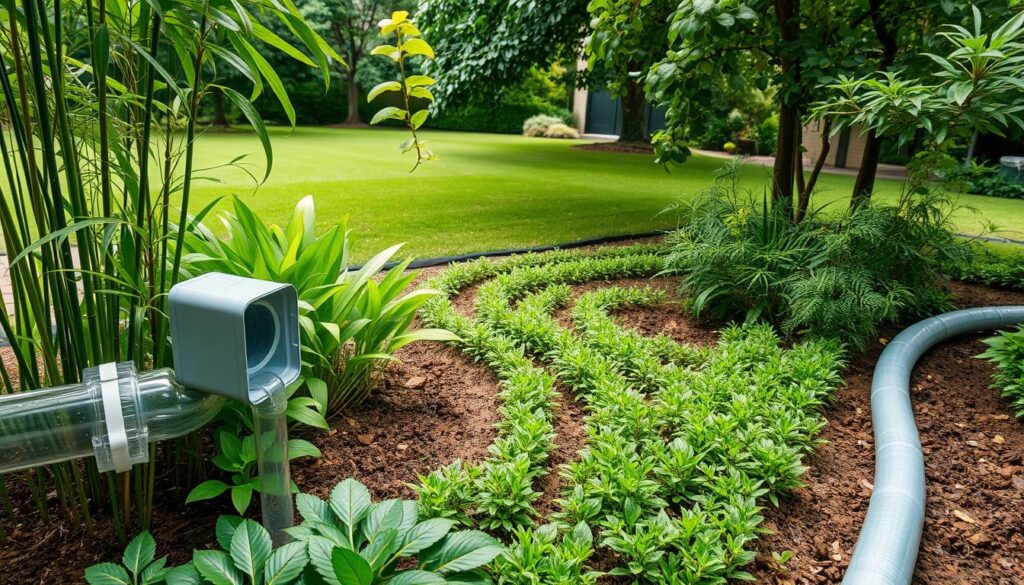
Nature’s Liquid Fertilizer
This water solution does double duty. As Sustainable Home Magazine experts explain: “Greywater delivers phosphorus and nitrogen directly to roots, acting like a slow-release plant food.” You’ll see stronger growth in fruit trees and ornamentals compared to tap water alone. Just avoid harsh chemicals—opt for biodegradable soaps.
Mapping Your Landscape’s Needs
Sunny spots with sandy soil need more frequent watering than shaded clay areas. Observe how water moves across your yard after rain. Slopes over 5% might require terraced mulch basins to prevent runoff. For citrus trees, position basins 3 feet from trunks to match their root spread.
Soil type determines absorption speed. Sandy earth drains three times faster than loam, so adjust your irrigation timing. Clay-heavy gardens benefit from woodchip-filled trenches that filter water gradually. Pair these techniques with drought-tolerant plants, and you’ll cut outdoor water use by up to 50% during summer restrictions.
Designing Efficient Greywater Irrigation Systems
Your washing machine could become your garden’s best ally with simple tweaks. Whether you’re hands-on with tools or prefer professional solutions, there’s a greywater strategy that fits your lifestyle. Let’s explore methods that turn routine tasks into eco-friendly watering routines.
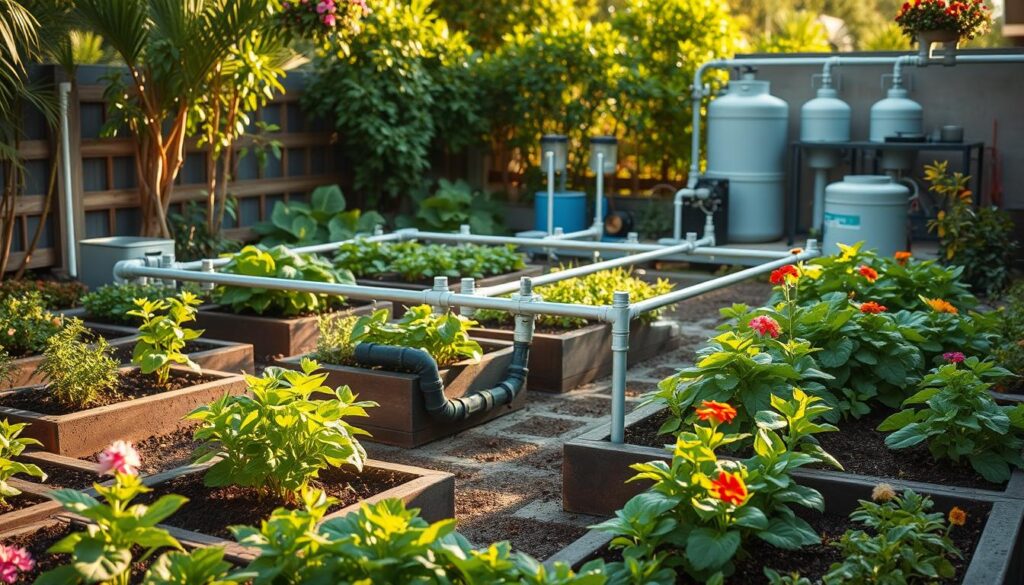
Start Small With Everyday Containers
Place a bucket under kitchen sinks while rinsing vegetables or waiting for hot water. A family of four can collect 8-12 gallons weekly this way. Showers offer another opportunity—use a portable tub to catch water during your 5-minute warm-up. Sustainable Home Magazine found these methods reduce outdoor water use by 25% in test homes.
Upgrade With Purpose-Built Plumbing
For larger needs, install a washing machine diverter valve. This $150-$300 device redirects 15-40 gallons per load to mulch basins. Calculate your potential savings: 10 loads weekly × 30 gallons = 300 gallons monthly. Adjustable emitters let you customize flow for thirsty fruit trees versus delicate flowers.
“Our clients save 60% on irrigation costs within two seasons by pairing diverter valves with timed distribution,” notes a Sustainable Home Magazine case study.
Always use phosphate-free soaps to protect soil health. Test your setup monthly by checking plant roots for sogginess—proper drainage prevents salt buildup. With smart adjustments, your system grows alongside your landscape’s needs.
Implementing Greywater-Safe Garden Planning
Your yard transforms into a living filter when you match water sources to plant needs. Sustainable Home Magazine recommends focusing on species that thrive with steady moisture and mild nutrients. Start by observing which areas get consistent shade or sun—this determines where different vegetation will succeed.
Smart Plant Partnerships
Fruit trees like apples and lemons excel with greywater’s phosphorus boost. Their deep roots absorb moisture before it evaporates. California Sycamore trees make ideal partners, needing 20% less irrigation than non-native species once established.
Earth’s Natural Sponges
Dig trenches 12 inches deep beneath tree canopies—this is where feeder roots drink. Fill them with untreated woodchips to create mulch basins. One cubic yard of chips handles 50 gallons weekly. As chips break down, they naturally balance water’s pH from 8.5 to 7.2 within six months.
| Plant Type | Basin Depth | Weekly Water |
|---|---|---|
| Citrus Trees | 14-16″ | 25-35 gal |
| Berry Bushes | 8-10″ | 10-15 gal |
| Native Grasses | 6-8″ | 5-8 gal |
Slope Solutions
On 10% grades, build terraced basins every 4 feet to prevent runoff. Use adjustable emitters to control flow—desert climates need 30% less water than coastal zones. Test soil monthly; sandy types may require extra woodchips to slow drainage.
“Terraced mulch systems reduced erosion by 78% in our Arizona trial sites,” reports Sustainable Home Magazine.
Rotate watering zones weekly to let soil breathe. This prevents salt buildup while keeping roots robust through dry spells. Your landscape becomes a customized ecosystem that works with nature’s rhythms.
Embracing Sustainable Practices for a Greener Home
Every shower you take and load of laundry you wash holds hidden potential. The EPA reports U.S. homes waste 300 gallons of water daily—enough to fill three bathtubs. By redirecting this resource, you protect local ecosystems while cutting utility bills.
Simple changes create big impacts. Switch to phosphate-free soaps that nourish soil instead of harming it. Check local codes—most states allow basic greywater systems without permits if you follow safety guidelines.
During droughts, these setups become lifelines. A Sustainable Home Magazine study found landscapes using recycled water stayed 73% greener than others during restrictions. One Arizona family saved $1,200 annually by irrigating fruit trees with laundry runoff.
Start today:
- Collect sink water in buckets for potted plants
- Install a $25 hose diverter on washing machines
- Join neighborhood workshops to share solutions
Your actions ripple outward. When communities adopt these practices, we build drought resilience together—one drop at a time.

